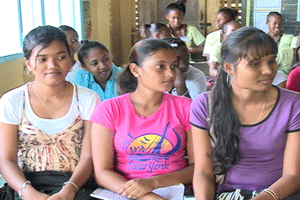More youth activities
THROUGH this column, numerous reports in the media and documentaries, Guyanese have become more aware of a significant intervention with a multi-pronged approach aimed at making communities safer and providing opportunities for those young people who would have lost that for some reason or the other.  The Citizen’s Security Programme Community Action Component is intended to, in addition to the skills and vocational training, expose youth to socio-cognitive skills training with the aim of reducing the vulnerability of the communities to crime and violence and to better expose them to partner with the Guyana Police Force to prevent crime and violence.
The Citizen’s Security Programme Community Action Component is intended to, in addition to the skills and vocational training, expose youth to socio-cognitive skills training with the aim of reducing the vulnerability of the communities to crime and violence and to better expose them to partner with the Guyana Police Force to prevent crime and violence.
The Programme is being implemented in the communities of Agricola, Buxton, Lusignan, Sophia and — in Region 4 (Demerara-Mahaica), and Port Moraunt, Kilcoy/Chesney/Fyrish, Rose Hall, Angoy’s Avenue and Overwinning/Edinburgh in Region 6 (East Berbice-Corentyne).
The Life Skills component of the programme has three separate consultancies: Youth Violence Prevention, Intimate Partner Violence Prevention and Child Abuse Prevention. These programmes are intended to assist the Ministry of Home Affairs to begin to transform the attitudes and behaviours of citizens away from criminal and violent activity. Consultants are expected to assist the CSP by delivering training on the strategies for the prevention violence. Through the process of training, the consultants will raise the awareness of community-level crime and violence.
The Youth Violence and Intimate Partner Violence Prevention for Region Six commenced in August 2011, and targets youth who are registered for the CSP vocational Training programmes as well as others in the communities. Participants of these programmes were exposed to modules on Understanding Self and Identity, Developing an Appreciation for Diversity, Interpersonal Relationships, Key Components of Violence Prevention, Communication and Decision Making, and Living in a Violence-free Zone. Participatory learning techniques and experiential approaches were applied with the groups. These included the use of relevant icebreakers, flash cards, general group discussions lead by the consultant as well as led by participants. Story-telling, case studies and role plays were also used. Additionally, audio visual materials were utilized. Personal reflections were also used.
Violence prevention participants designed, planned, and implemented community projects as part of the requirement for the module on Living in a Violence-Free Zone. Participants, through their own initiatives, implemented projects which were innovative. Those projects included making a mural, a book marker, and a calendar with anti-violence messages; organising a youth community concert, and a community walk-through where one-on-one discussions were held on violence prevention and handouts distributed.
Some 57 individuals (comprising adults and youth) were trained as Facilitators and Peer Educators, and consultants are currently mentoring the trained facilitators and Peer Educators as they facilitate sessions with In-School Youth, Out-of-School Youth in Organised Settings, religious groups and other interest groups. To date, Peer Educators have facilitated sessions with over 380 persons in Region 6.
As part of the work plan for the Youth Violence Prevention Programme for Region 6, the CAC embarked on an intensive series of debate competitions. These were used provide a forum for youth to develop and showcase the art of expression, thereby allowing them to communicate their ideas, and build confidence in public speaking. Additionally, the debate is seen as an innovate method of disseminating information on Violence Prevention to Youths and other residents within the target communities, as they come to cheer on their friends and family members on the debating team.
It was a true partnership among Trained Peer Educators, Consultants and the Community Action Officers, teachers from schools in the communities, religious and other community leaders.
On June 2, 2012, residents of Tain/Port Mourant were treated to an avid debate on the relationship between alcohol and violence at the God of the Change International Church, where six Peer Educators from Port Mourant presented supporting and opposing arguments on the Moot: ‘Alcohol abuse is the main cause of violence in our society’. Judges were hard-pressed to identify a winning team.
This process was repeated at the Kilcoy/Chesney Community Centre on June 3, 2012 where several youths witnessed a debate among Youth Violence and Intimate Partner Violence Peer Educators from Kilcoy/Chesney and Fyrish, who presented their arguments on a similar Moot.
Overwinning/Edinburgh witnessed a debate among their Peer Educators on the Moot: ‘Violence is Learnt Behaviour’on June 9th at the Glasgow Multipurpose Building.
This process has seen youth who were generally shy and introverted at the beginning of the Violence Prevention Programmes stand up and voice their positions on the violence related issues with such conviction and passion that the judges and audiences were blown away by the presentations of the respective teams.
The debate was then taken to another level with the winning teams being taken to debate another community under the programme, and the winner of that inter community debate will debate another community and the process continues.
This Father’s Day, which is being celebrated today, Kilcoy/Chesney/Fyrish will debate Port Mourant on the Moot: ‘Corporal punishment should not be used as a form of discipline’. This should be another interesting one in the series, with Peer Educators , Bibi Shameeza Iatally and Preeya Persaud taking on Radha Dyadat, Niaomi Singh and Stevon Gangaprashad.
The winners of this competition will go on to debate Overwinning/Edinburgh on June 24.
CSP weekly…
SHARE THIS ARTICLE :
Facebook
Twitter
WhatsApp



.jpg)








